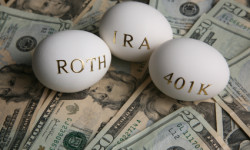In some recent posts on investing, I’ve covered the importance of getting in the game as soon as possible so you get the financial wind (compound interest) blowing in the right direction. And I’ve emphasized the importance of asset allocation, noting that one of the easiest ways to get the proper allocation is to invest in a good target date fund.
Now let’s make sure we hang onto as much of our investment return as possible.
Consider a Roth IRA
If you have earned income – money you earn as opposed to money given to you by your generous parents, for example – and don’t earn too much income (less than $169,000 if married and filing jointly, or less than $107,000 if single or married and filing separately), you may qualify for one of my favorite investment tools, a Roth IRA.
A Roth IRA is not an investment. It’s a vehicle through which you make investments.
Mutual funds and stocks are investments. But if you invest in either one through a Roth IRA, you’ll get some important tax benefits.
While there’s no immediate tax break on the money you put in (it doesn’t lower your taxable income), you get some nice tax benefits from that point forward. You don’t pay taxes on any money you earn (capital gains taxes) and you don’t pay taxes on the money once you start taking it out in your retirement (income taxes).
All of the big brokerage houses – Vanguard, Fidelity, T. Rowe Price, Schwab, etc. – will help you set up a Roth IRA.
Extra Benefits of a Roth IRA
Maybe you’re concerned about not being able to touch that money until you’re old and gray. While it’s true that it’s best to invest for your retirement with the mindset that you won’t, in fact, touch the money until you’re old and gray, a Roth comes with some flexibility. You can withdraw the money you put into it at any time with no taxes or penalty.
You can also tap the earnings tax- and penalty-free for certain purposes, such as a first-time home purchase, after you’ve had a Roth for five years.
Here are two even more important benefits of a Roth. You don’t have to start taking the money out at age 70 and a half as you do with a traditional IRA and you don’t have to stop contributing at that age as you do with a traditional IRA.
Let’s face it, a lot of us will have to work well past the culturally-defined retirement age of 65. And, assuming we don’t max out our cholesterol contributions, we stand a decent chance of living well past 70. The ability to keep investing in our 70s will likely come in handy.
Using a Roth IRA Along With Your Workplace Program
The first step with retirement investing is to figure out how much you should invest by running a simple needs analysis (Click on “See how much you may need to save for retirement”).
If you have access to a workplace retirement program like a 401(k) or a 403(b) that matches a portion of what you contribute to the plan, invest whatever amount your employer will match. It’s the easiest money you’ll ever make.
Let’s say you earn $60,000 per year and you determine that you need to put $4,800 into a retirement account each year. Now let’s say your employer will match your contributions dollar for dollar up to six percent of your salary ($3,600). I’d recommend investing $300 a month into that plan and $100 per month through a Roth.
The workplace program gives you an amazing benefit in the form of the match. Going through a brokerage house to round out your retirement investment plan with a Roth IRA will typically give you more investment choices than your workplace, you’ll probably end up paying less in fees, and you’ll gain the other benefits of a Roth IRA that we discussed above.
Are you using a combination of a workplace retirement plan and a Roth IRA? Why or why not?
If you know someone else who would benefit from this article, please forward a link. And if you haven’t done so already, you can subscribe to this blog by clicking here. Two or three times a week, you’ll receive ideas and encouragement for using money well.



I think the fact that there are no minimum required distributions after 70 1/2 and that you can continue growing the account (through investment earnings and additional contributions) is a bigger advantage than most of us assume.
Since people are living into their 80s and 90s, having at least one account that keeps growing will be huge. Inflation won’t stop when you hit 65 or 70, and the later years of retirement will need to be funded. A Roth handles that perfectly–other retirement accounts are programmed to deplete.
Jerry – Good question. There are restrictions as to whether you can make deductible contributions to a TRADITIONAL IRA based on participation in a workplace plan and income. However, there are no workplace plan participation-related restrictions impacting contributions to a ROTH IRA – there are only income-based restrictions.
There’s a good list of rules and regs here:
http://www.smartmoney.com/retirement/planning/an-ira-primer-7957/
My understanding was that you can have both an Roth IRA and a 401K, BUT you one cannot put money into both in the same tax year (or you will be disqualified from the tax advantage of the Roth). If that’s incorrect, what’s the truth?